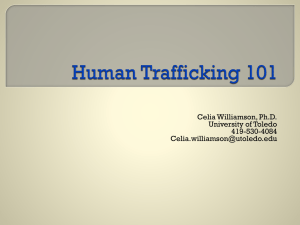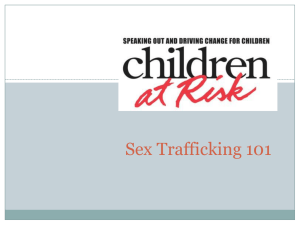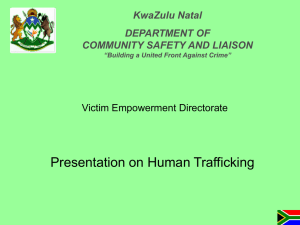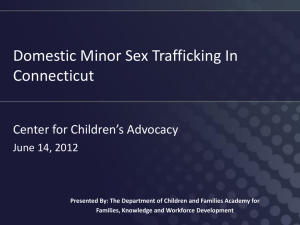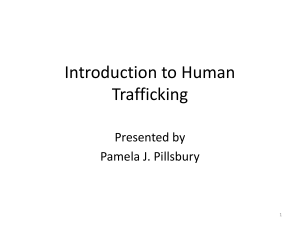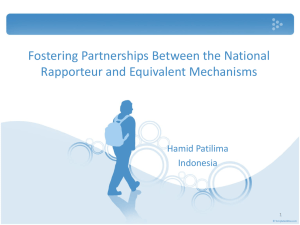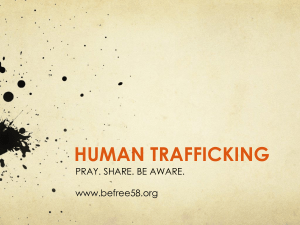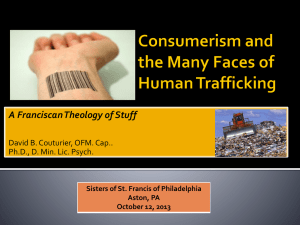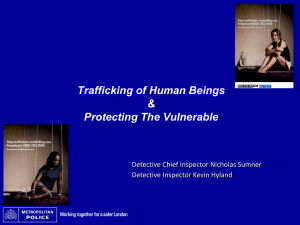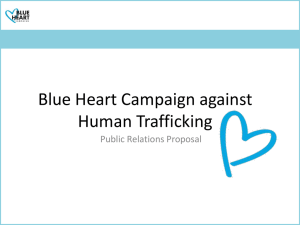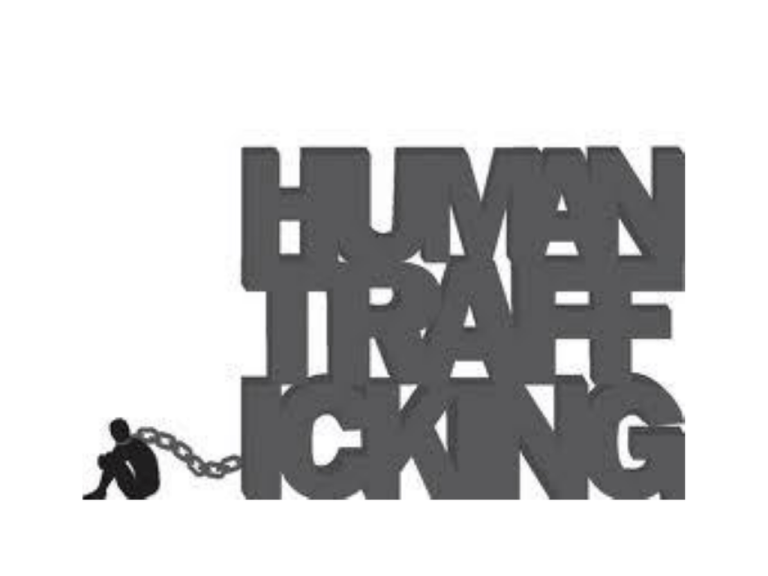
Cpl. Beth Clodfelter
GTCC Police Department
336-334-4822 x-52529
January Is Human Trafficking
Awareness month
• In 2012, North Carolina proclaimed January as
Human Trafficking month to bring greater
awareness and reporting of human trafficking.
• In 2012, President Obama recognized January
as National Slavery and Human Trafficking
Prevention Month.
• January is also the month in which the
Emancipation Proclamation freed slaves
during the Civil War.
What is Human Trafficking?
• Human Trafficking is a form of modern day
slavery in which traffickers exploit human
beings for money.
Types of Trafficking
• There are three types of trafficking:
Labor trafficking
Domestic servitude - Domestic servitude is a special
category of labor trafficking: the plight of domestic workers such as maids,
servants, housekeepers, child-care givers, those caring for the elderly, the ill,
and the infirm. In many instances, some of these duties may overlap.
-
Sex trafficking
The Making of a Girl
http://www.youtube.com/watch?v=ZvnRYte3PA
k&noredirect=1
(Copy and paste in browser if link doesn’t work)
Fraud, Force and/or Coercion
• Under Federal and State law, both labor trafficking and
adult sex trafficking involve the use of fraud, force or
coercion to recruit or control victims.
• Traffickers often physically force victims to work or
engage in commercial sex, defraud them with false
promises of legal work, or coerce them through
brainwashing and violence.
• Because minors are vulnerable and cannot consent to
sex , they can be exploited in sex traffic even without
actual fraud, force of coercion.
Labor Trafficking
• Over 12 million people worldwide are
trafficked in forced labor, domestic servitude,
and debt bondage; at least 500,000 of them
are in Europe and the United States.
Human Trafficking
• Trafficking is a $32 Billion industry that treats people as
property to be used and reused over and over again.
Traffickers lure and control victims through force, fraud, or
coercion, or minors’ increased vulnerability.
• Trafficking is profitable because there is global demand for
cheap slave labor in many industries, ranging from coffee
and cocoa production to prostitution and pornography.
• Human trafficking is already the second or third largest
criminal enterprise worldwide and is now the fastest
growing.
• Human trafficking is extremely profitable because, unlike
contraband that can be sold only once, each human being
can be sold numerous times.
North Carolina
• According to federal reports, NORTH CAROLINA ranks
as the eighth most likely place in the nation for human
trafficking to occur.
• The U.S. is ranked as the third largest destination
country (a country into which victims are trafficked).
• Hundreds of thousands of U.S. citizens are trafficked
within the U.S. each year.
• North Carolina’s multiple highways, isolated rural
areas, and existing gang networks facilitate the supply
of trafficking victims; its agricultural industry, tourist
destinations, and military installations facilitate some
of the demand.
From Place to Place
http://www.youtube.com/watch?v=oSrxSRbnHg
(Copy and paste in browser if link doesn’t work)
Recruiting
• Most pimps recruit victims by targeting
vulnerable individuals, then posing as loving
caretakers who can meet victims’ needs for
love and financial support. Others may kidnap
victims or adopt them through social service
agencies.
• Labor traffickers target refugees, immigrants,
and low-income individuals and recruit them
with false promises of paid work.
Grooming
• To break down victims’ resistance to engaging in
prostitution, pimps “groom” victims by building their
trust, then convincing them prostitution is normal or will
show their love.
• Traffickers also groom victims through physical and
emotional abuse, rape, confinement, deprivation,
isolation, and elaborate mind control techniques (such as
controlling victims’ smallest decisions and forcing them to
abandon their identities).
• Pimps control victims by continuing this abuse and
manipulation.
Foster Care
• Foster care children are especially vulnerable
to sex trafficking because the vast majority
has already been abused, neglected, or
treated as a source of income by family
figures.
• 50-95% of sex trafficking victims have already
been in foster care.
Homeless Youth
• Between 100,000 and 300,000 minors in the U.S. are at
risk of being trafficked into commercial sexual
exploitation. (E.g., U.S. Department of State; Polaris)
• Homeless youths are typically approached by a pimp
within the first 48 hours of being on the streets. Pimps
target these children, who typically have no means of
support.
• Between 40-70% of homeless youth engage in
prostitution for survival.
• Approximately 75% percent of all sex trafficking victims
have been homeless.
What I Have Been
Through Is Not Who I Am
http://www.youtube.com/watch?v=BmmRTjoL3
R0
(Copy and paste in browser if link doesn’t work)
Effects of Technology & Social Media
• Traffickers use technology to recruit victims
through social networking websites
(Facebook, Twitter) and communicate with
purchasers through online ads and dating
websites (Backpage, PlentyofFish).
• The website Backpage.com carries
approximately 70% of all online prostitution
ads in the US.
Vulnerability Factors
• The factors that make people most vulnerable
to being trafficked are:
Being young
Low income
Female
Previously abused
Refugees
In need of work abroad
Types of Traffickers
• The most common profile of a trafficker is a
male who traffics people within his own
country, but traffickers include males and
females operating as pimps, brothel owners,
business owners, and members of gangs or
international criminal organizations.
Gangs
• As criminal gangs have grown in number and
size, they have become increasingly involved
in trafficking as another profitable illegal
enterprise.
Sex Offenders
• In 2013, North Carolina SB 122 became law,
mandating that all convicted sex traffickers
register as sex offenders.
Safe Harbor
• Like other states’ Safe Harbor Laws, North
Carolina’s Safe Harbor Act focuses on helping
victims and prosecuting traffickers.
• North Carolina’s new Safe Harbor Act lets victims
recover lost wages from their traffickers and
erase criminal records from being sex trafficked
as minors.
• The Act increases punishments and prevents
purchasers from claiming either that a minor
prostitute consented or that they did not know a
minor prostitute’s age.
Shaniya’s Law
• Shaniya’s Law, passed in honor of child
trafficking victim Shaniya Davis, makes it a
state felony and a potential sex registry
offense to sell, surrender, or buy a minor child.
This happened in NORTH CAROLINA!
Shaniya’s Law
http://www.youtube.com/watch?v=QBPycCbcBZ
U
(Copy and paste in browser if link doesn’t work)
Boys and Men
• Approximately 20-46% of all trafficking victims are
male.
• The average age of boys first being sex trafficked is
11-13 years old.
Everybody
• 27 million men, women and children are held
in modern-day slavery around the world.
Who drives the demand?
• Approximately 1 in 5 or 6 men in the U.S. admits to having paid
for sex.
• These purchasers drive demand and come from all
socioeconomic, racial, and educational backgrounds; almost
half are married.
Get Involved!
If you suspect it, report it.
Be an advocate, volunteer…
**DO NOT BE A BYSTANDER**
Report Human Trafficking Crimes
to your
Local Police Department
OR
GTCC PD @ 334-4822 x-52529
OR
Greensboro Crime$toppers @ 373-1000
OR
High Point Crime$toppers @ 889-4000
**DO NOT BE A BYSTANDER**
Contact GTCC Counseling Services at
336-334-4822 x- 50038
if you are in need of assistance
Thank You!
http://www.nccasa.net/

